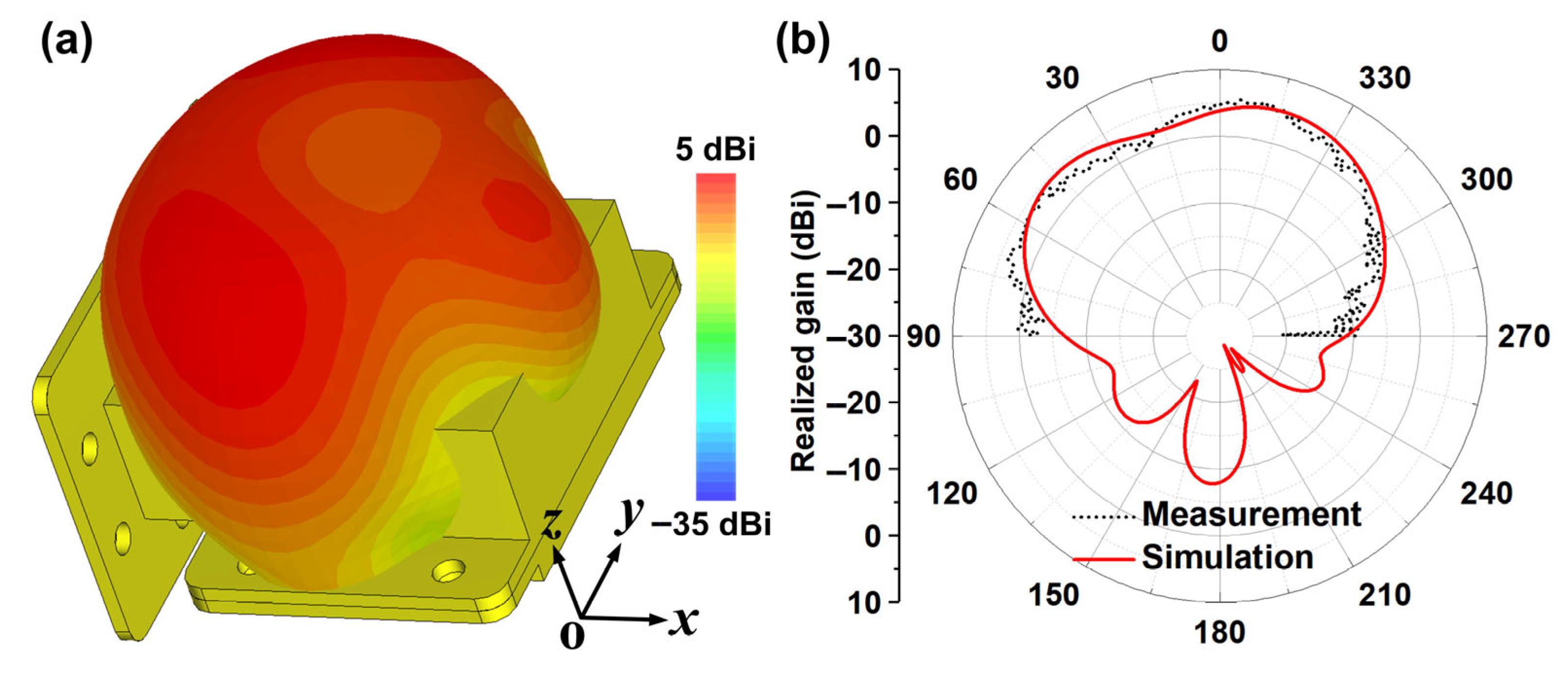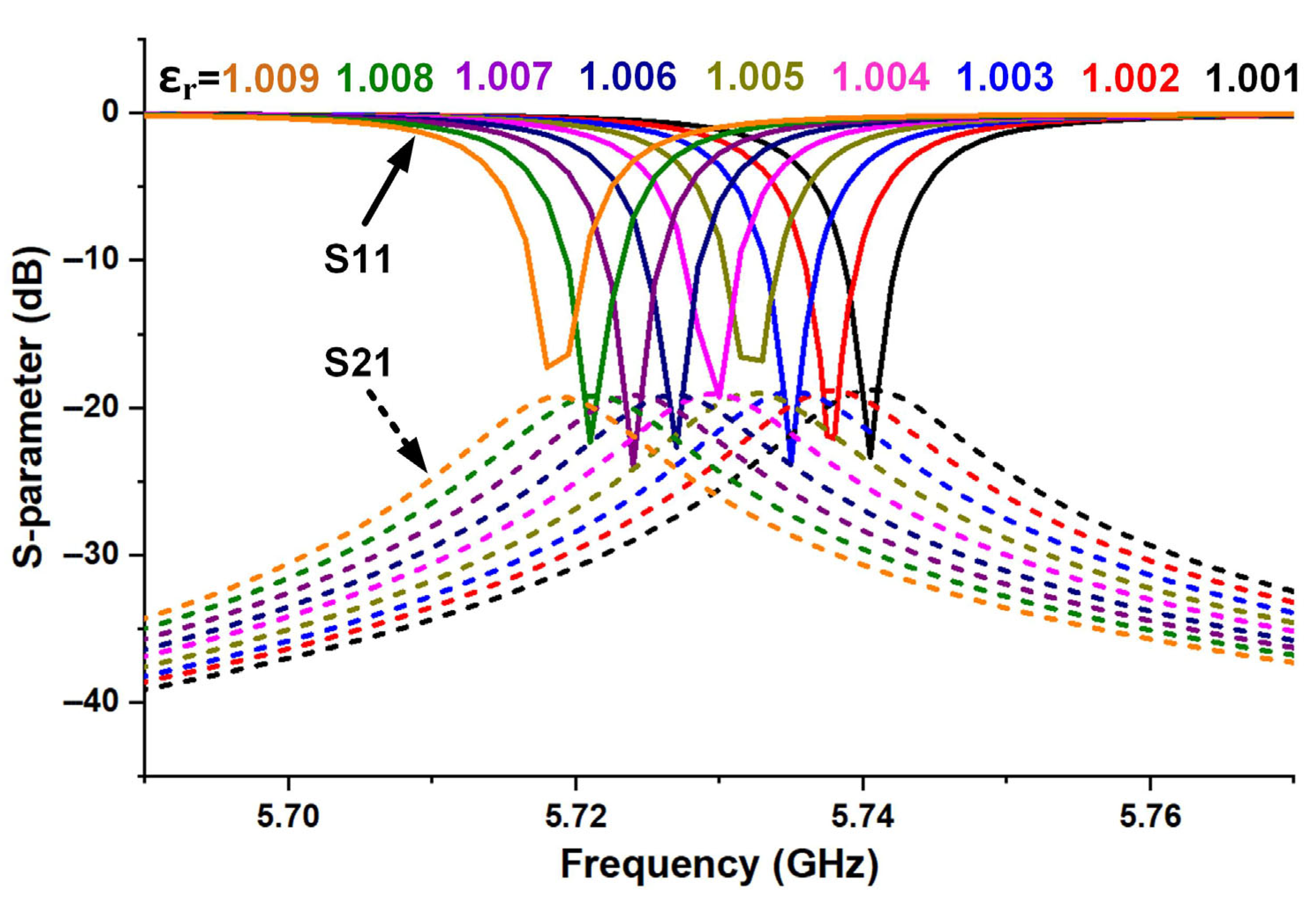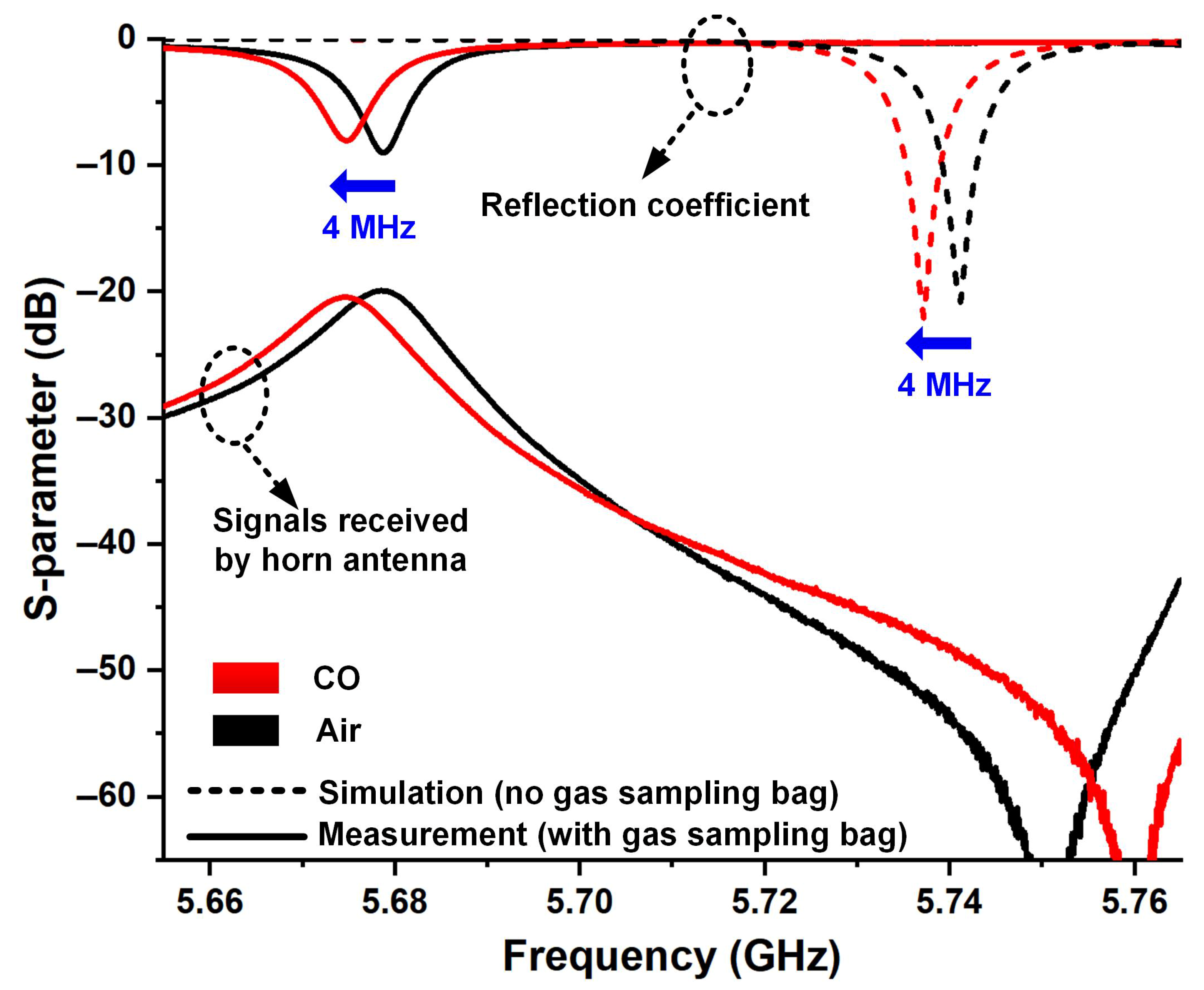Microwave Detection of Carbon Monoxide Gas via a Spoof Localized Surface Plasmons-Enhanced Cavity Antenna
Abstract
1. Introduction
2. Methods
3. Results
4. Conclusions
Author Contributions
Funding
Data Availability Statement
Conflicts of Interest
References
- He, Y.Y.; Jiao, M.Z. A Mini-Review on Metal Oxide Semiconductor Gas Sensors for Carbon Monoxide Detection at Room Temperature. Micromachines 2024, 12, 55. [Google Scholar] [CrossRef]
- Fine, G.F.; Cavanagh, L.M.; Afonja, A.; Binions, R. Metal Oxide Semi-Conductor Gas Sensors in Environmental Monitoring. Micromachines 2010, 10, 5469–5502. [Google Scholar] [CrossRef] [PubMed]
- Sun, M.; Yu, H.; Zhang, K.; Wang, S.; Hayat, T.; Alsaedi, A.; Huang, D. Palladacycle Based Fluorescence Turn-On Probe for Sensitive Detection of Carbon Monoxide. ACS Sens. 2018, 3, 285–289. [Google Scholar] [CrossRef] [PubMed]
- Wang, M.; Sun, S.T.; Yao, Q.; Zhang, X.R.; Xu, Z.X.; Cheng, Z.W.; Yang, J. A High-sensitive Cavity Sensor Antenna with Interference Suppression Ability Based on Spoof Localized Surface Plasmons. IEEE Trans. Instrum. Meas. 2025, 74, 6008111. [Google Scholar] [CrossRef]
- Ozbay, E. Plasmonics: Merging photonics and electronics at nanoscale dimensions. Science 2006, 311, 189–193. [Google Scholar] [CrossRef]
- Verma, S.; Pathak, A.K.; Rahman, B.M.A. Review of Biosensors Based on Plasmonic-Enhanced Processes in the Metallic and Meta-Material-Supported Nanostructures. Micromachines 2024, 15, 502. [Google Scholar] [CrossRef]
- Ono, A.; Sano, H.; Inami, W.; Kawata, Y. Surface Plasmon Excitation and Localization by Metal-Coated Axicon Prism. Micromachines 2012, 3, 55–61. [Google Scholar] [CrossRef]
- Shen, X.; Cui, T.J. Ultrathin plasmonic metamaterial for spoof localized surface plasmons. Laser Photonics Rev. 2014, 8, 137–145. [Google Scholar] [CrossRef]
- Shen, Y.; Chen, N.; Dong, G.; Hu, S. Manipulating multipole resonances in spoof localized surface plasmons for wideband filtering. Opt. Lett. 2021, 46, 1550–1553. [Google Scholar] [CrossRef]
- Garcia-Vidal, F.J.; Fernández-Domínguez, A.I.; Martin-Moreno, L.; Zhang, H.C.; Tang, W.X.; Peng, R.W.; Cui, T.J. Spoof surface plasmon photonics. Rev. Mod. Phys. 2022, 94, 025004. [Google Scholar] [CrossRef]
- Zhang, X.; Cui, W.Y.; Lei, Y.; Zheng, X.; Zhang, J.; Cui, T.J. Spoof Localized Surface Plasmons for Sensing Applications. Adv. Mater. Technol. 2021, 6, 2000863. [Google Scholar] [CrossRef]
- Zhu, S.L.; Gao, L.F.; Cui, J.L.; Hu, Y.L.; Zhu, X.F.; Yuan, H.Y. A Material Characteristic Measurement System for HTWT Support Rods Based on SLSP Resonator and Simulation-Driven Calibration. IEEE Trans. Instrum. Meas. 2025, 74, 1–9. [Google Scholar] [CrossRef]
- Wan, M.; Wang, J.P.; Bao, D.; Fan, F.; Gao, H.; Qu, Z.Y.; Cui, T.J. Terahertz GaAs Indicator Chip Based on High-Q-Factor Spoof Localized Surface Plasmons Resonator. Laser Photonics Rev. 2025, 19, 2401749. [Google Scholar] [CrossRef]
- Wan, M.; Li, C.; Bao, D.; Wang, J.; Lu, K.; Qu, Z.; Gao, H. Terahertz CMOS High-Sensitivity Sensor Based on Hybridized Spoof Surface Plasmon Resonator. Photonics 2025, 12, 102. [Google Scholar] [CrossRef]
- Arif, A.; Zubair, A.; Riaz, K.; Mehmood, M.Q.; Zubair, M. A Novel Cesaro Fractal EBG-Based Sensing Platform for Dielectric Characterization of Liquids. IEEE Trans. Antennas Propag. 2021, 69, 2887–2895. [Google Scholar] [CrossRef]
- Wang, J.; Yan, S.Z.; Kong, X.L.; Xu, R.F.; Zhao, L. High-Q sensor based on hybridized spoof localized surface plasmons. Opt. Express. 2024, 32, 46862–46872. [Google Scholar] [CrossRef]
- Liao, Z.; Peng, X.; Liu, L.L.; Xu, Y.H.; Xu, K.D.; Pan, B.C.; Luo, G.Q.; Liu, Y.M. Microwave Plasmonic Exceptional Points for Enhanced Sensing. Laser Photonics Rev. 2023, 17, 2300276. [Google Scholar] [CrossRef]
- Nie, H.K.; Xuan, X.W.; Shi, Q.; Guo, A.; Li, M.J.; Li, H.J.; Ren, G.J. Wearable Antenna Sensor Based on EBG Structure for Cervical Curvature Monitoring. IEEE Sens. J. 2022, 22, 315–323. [Google Scholar] [CrossRef]
- Wei, W.Q.; Fan, X.Y.; Wang, Y.L.; Fang, W.J.; Cao, R.Q.; Yin, Y.X.; Wei, X.; Li, C.C.; Tao, J.F.; Kumar, S. Tunable multi-channel sensing and bidirectional optical switching enabled by all-dielectric metasurfaces with Quasi-BIC Fano resonances. Phys. Scr. 2025, 100, 065539. [Google Scholar] [CrossRef]
- Cao, S.S.; Fan, X.Y.; Fang, W.J.; Du, M.C.; Sun, Q.H.; Niu, H.J.; Li, C.C.; Wei, X.; Bai, C.L.; Tao, J.F.; et al. Multi-function sensing applications based on high Q-factor multi-Fano resonances in an all-dielectric metastructure. Biomed Opt Express. 2024, 15, 2406–2418. [Google Scholar] [CrossRef]
- Ai, Z.; Liu, H.F.; Cheng, S.B.; Zhang, H.F.; Yi, Z.; Zeng, Q.D.; Wu, P.H.; Zhang, J.G.; Tang, C.J.; Hao, Z.Q. Four peak and high angle tilted insensitive surface plasmon resonance graphene absorber based on circular etching square window. J. Phys. D: Appl. Phys. 2025, 58, 185305. [Google Scholar] [CrossRef]
- Chu, S.F.; Wang, Q.; Yu, L.; Gao, H.X.; Liang, Y.Z.; Peng, W. Numerical Investigation on Multiple Resonant Modes of Double-Layer Plasmonic Grooves for Sensing Application. Nanomaterials 2020, 10, 308. [Google Scholar] [CrossRef] [PubMed]
- Li, G.J. Multiple Fano Resonance with Excellent Sensing in Rake-Shaped Graphene Nanostructure. Adv. Theory Simul. 2024, 8, 2400707. [Google Scholar] [CrossRef]
- Zhang, X.R.; Yan, R.T.; Cui, T.J. High-FoM Resonance in Single Hybrid Plasmonic Resonator via Electromagnetic Modal Interference. IEEE Trans. Antennas Propag. 2020, 68, 6447–6451. [Google Scholar] [CrossRef]
- Sherry, L.J.; Chang, S.H.; Schatz, G.C.; Van Duyne, R.P.; Wiley, B.J.; Xia, Y.N. Localized surface plasmon resonance spectroscopy of single silver nanocubes. Nano Lett. 2005, 5, 2034–2038. [Google Scholar] [CrossRef]
- Schmidt, M.A.; Lei, D.Y.; Wondraczek, L.; Nazabal, V.; Maier, S.A. Hybrid nanoparticle-microcavity-based plasmonic nanosensors with improved detection resolution and extended remote-sensing ability. Nat. Commun. 2012, 3, 1108. [Google Scholar] [CrossRef]








Disclaimer/Publisher’s Note: The statements, opinions and data contained in all publications are solely those of the individual author(s) and contributor(s) and not of MDPI and/or the editor(s). MDPI and/or the editor(s) disclaim responsibility for any injury to people or property resulting from any ideas, methods, instructions or products referred to in the content. |
© 2025 by the authors. Licensee MDPI, Basel, Switzerland. This article is an open access article distributed under the terms and conditions of the Creative Commons Attribution (CC BY) license (https://creativecommons.org/licenses/by/4.0/).
Share and Cite
Wang, M.; Xu, W.; Sun, S. Microwave Detection of Carbon Monoxide Gas via a Spoof Localized Surface Plasmons-Enhanced Cavity Antenna. Micromachines 2025, 16, 790. https://doi.org/10.3390/mi16070790
Wang M, Xu W, Sun S. Microwave Detection of Carbon Monoxide Gas via a Spoof Localized Surface Plasmons-Enhanced Cavity Antenna. Micromachines. 2025; 16(7):790. https://doi.org/10.3390/mi16070790
Chicago/Turabian StyleWang, Meng, Wenjie Xu, and Shitao Sun. 2025. "Microwave Detection of Carbon Monoxide Gas via a Spoof Localized Surface Plasmons-Enhanced Cavity Antenna" Micromachines 16, no. 7: 790. https://doi.org/10.3390/mi16070790
APA StyleWang, M., Xu, W., & Sun, S. (2025). Microwave Detection of Carbon Monoxide Gas via a Spoof Localized Surface Plasmons-Enhanced Cavity Antenna. Micromachines, 16(7), 790. https://doi.org/10.3390/mi16070790





